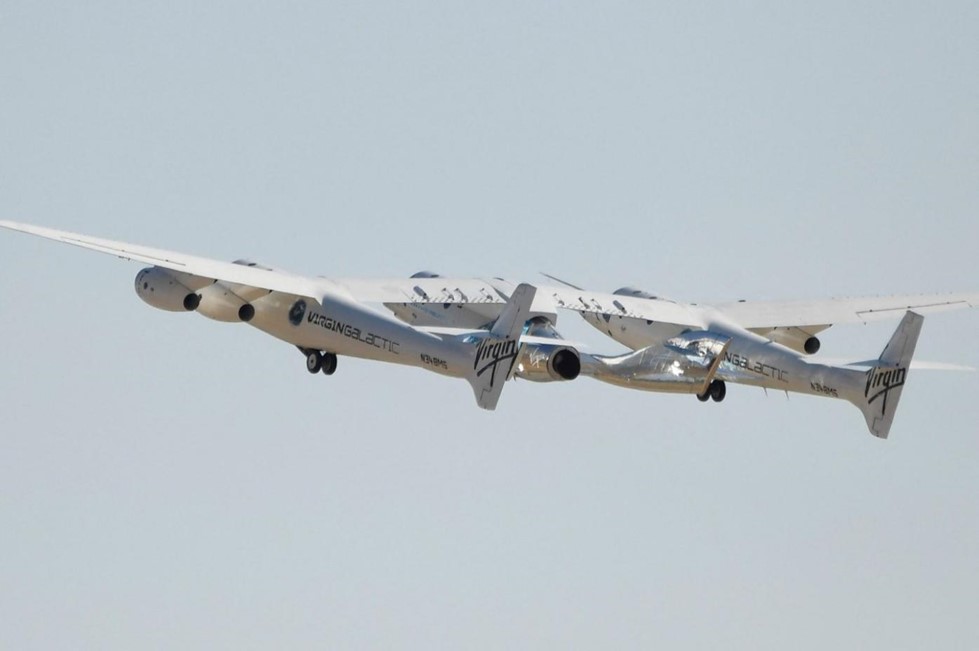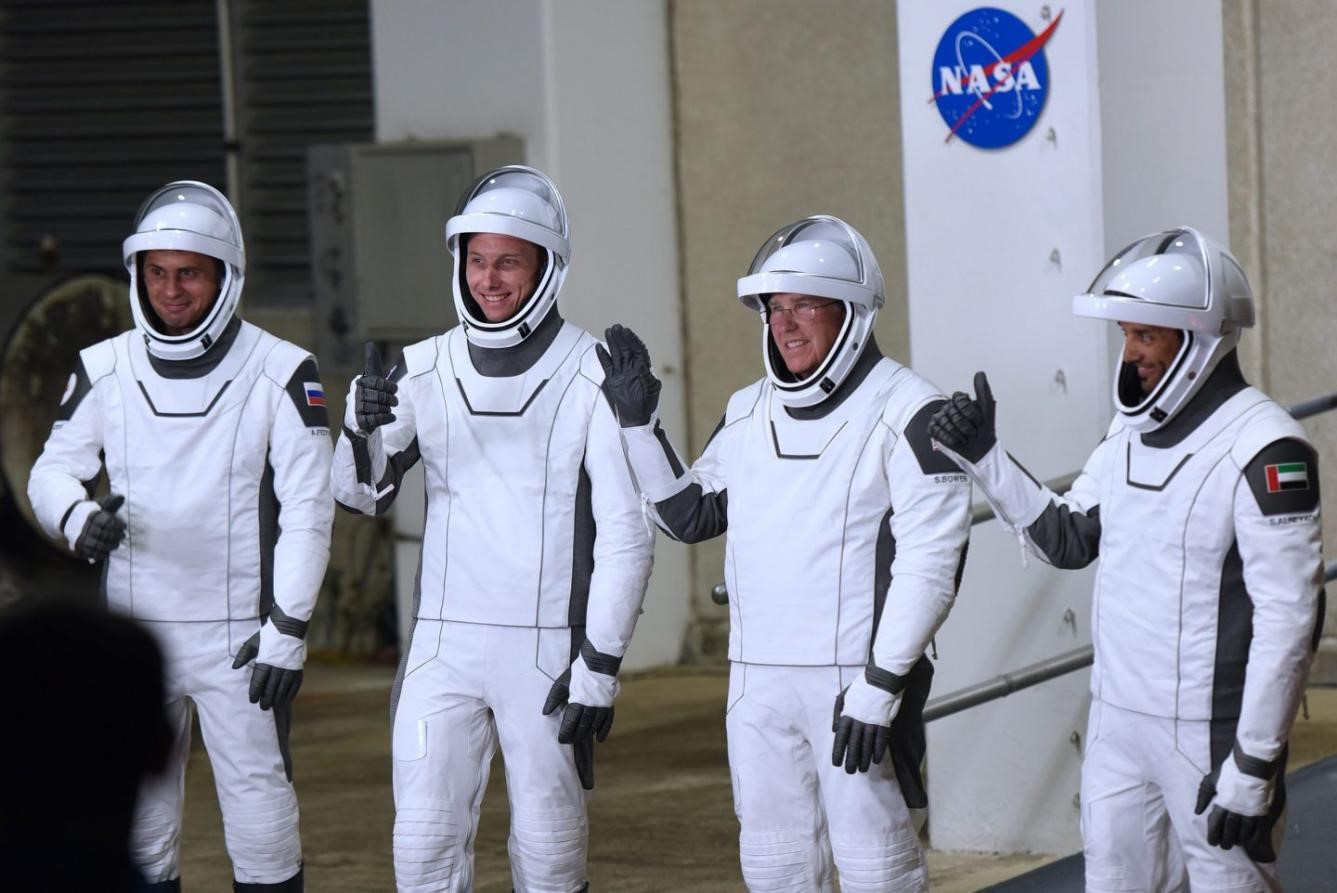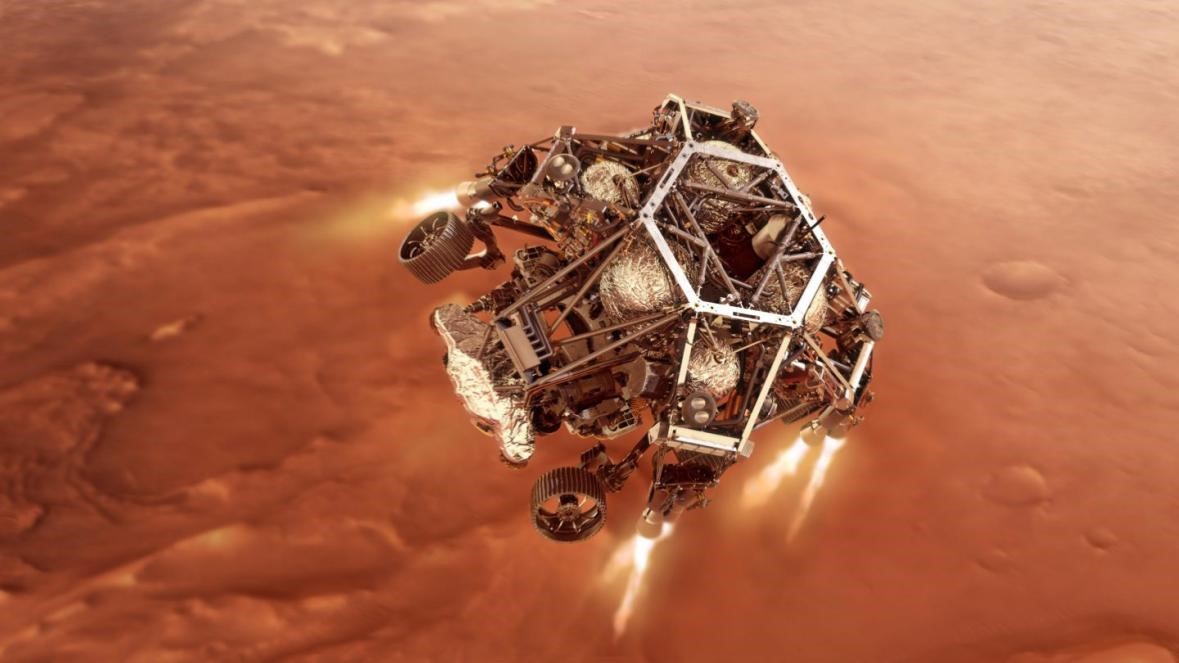 維珍銀河公司的太空船二號(SpaceShipTwo),。圖片來源:PATRICK T. FALLON—AFP/GETTY IMAGES
維珍銀河公司的太空船二號(SpaceShipTwo),。圖片來源:PATRICK T. FALLON—AFP/GETTY IMAGES似乎已經(jīng)沉寂數(shù)十年的太空探索活動(dòng),在過去幾年內(nèi)飛速增長,,達(dá)到前所未有的程度,。2022年共有186次成功的火箭發(fā)射,在曾經(jīng)主要與政府實(shí)體和國家競爭有關(guān)的航天業(yè),,例如埃隆·馬斯克的太空探索技術(shù)公司(SpaceX)等私營公司繼續(xù)突飛猛進(jìn),。
6月29日,維珍銀河(Virgin Galactic)發(fā)射了第一個(gè)完全商業(yè)化的航班,,將多人送入亞軌道太空,。
這是太空探索領(lǐng)域的最新里程碑。私營公司開始設(shè)計(jì)可以重復(fù)使用的火箭,、鞋盒甚至一副撲克牌大小的衛(wèi)星以及下一代太空服和變軌飛行器等,。而美國國家航空航天局(NASA)的科學(xué)家和研究人員則有精力思考更崇高的目標(biāo)。與此同時(shí),,政府支持的太空項(xiàng)目作為一些項(xiàng)目的主要用戶,,使公司有能力進(jìn)行創(chuàng)新、發(fā)展技術(shù),、實(shí)現(xiàn)規(guī)模經(jīng)濟(jì),,并把利潤投入到其他項(xiàng)目,包括新型的太空旅游領(lǐng)域,。
這個(gè)過程并非總是一帆風(fēng)順,。億萬富翁理查德·布蘭森的維珍軌道公司(Virgin Orbit)(從維珍銀河拆分后成立的公司)因?yàn)橐淮伟l(fā)射失敗而陷入財(cái)務(wù)困境,今年早些時(shí)候申請破產(chǎn),。但公私合作的機(jī)會不僅具有吸引力,,也令業(yè)內(nèi)的老牌公司感到興奮。太空探索領(lǐng)域最終的結(jié)果如何,,我們將迎來怎樣的未來,?
為了解各方面的觀點(diǎn),《財(cái)富》雜志聯(lián)系了五位美國專家,,其中有三位美國國家航空航天局宇航員和大力投資航天技術(shù),、太空旅行和衛(wèi)星圖像的兩家公司的高管,。以下是對話內(nèi)容,,因篇幅和清晰度對對話內(nèi)容進(jìn)行了編輯。
《財(cái)富》:我們?yōu)槭裁匆琅f需要探索太空,?
艾倫·奧喬亞,,四次航天飛機(jī)任務(wù)的機(jī)組成員,約翰遜航天中心(Johnson Space Center)第11位主任,第一位進(jìn)入太空的拉美裔女性:理由有很多,,但其中之一是為了科學(xué)探索,。我們或許已經(jīng)進(jìn)入太空五六十年之久,但我們對太空環(huán)境知之甚少,,并不了解能夠從太空中學(xué)到些什么。
邁克·摩西,,美國國家航空航天局任務(wù)管理團(tuán)隊(duì)前任主席,、維珍銀河現(xiàn)任總裁:我認(rèn)為,太空探索只是——它是人類的第二天性,,對嗎,?這是來自《星際迷航5:終極先鋒》(Stark Trek: The final frontier)的一句經(jīng)典臺詞。當(dāng)然還有一個(gè)原因是科技發(fā)展及其可能給地球上的生命帶來的好處,。我始終相信無畏,、宏大的目標(biāo)。
艾倫·奧喬亞:從某些方面來說,,最重要的理由是激勵(lì),。我認(rèn)為,如果某件事情很難或者根本不可能做到,,而你組建了一個(gè)團(tuán)隊(duì)并且最終取得成功,,這就可以引起人們的共鳴。美國國家航空航天局在歷史上不斷給人們帶來激勵(lì),。
斯坦·洛夫,,“亞特蘭蒂斯號”航天飛機(jī)(Space Shuttle Atlantis)的機(jī)組成員、宇航員辦公室(Astronaut Office)快速原型設(shè)計(jì)實(shí)驗(yàn)室(Rapid Prototyping Laboratory)的副主管,、“獵戶座”(Orion)飛船的駕駛艙顯示和控制系統(tǒng)設(shè)計(jì)者:有一位美國國家航空航天局的主管曾經(jīng)談到探索太空的理由:增強(qiáng)國家團(tuán)結(jié),,促進(jìn)國際團(tuán)結(jié),發(fā)展工程和科技,,鼓舞人類的探索精神,。還有一個(gè)實(shí)際的理由,那就是這是一件很酷的事情,。

私營行業(yè)的發(fā)展帶來了哪些變化,?
邁克·薩菲揚(yáng),,Planet(生成日常地球衛(wèi)星圖像)發(fā)射業(yè)務(wù)副總裁:通常情況下,航天業(yè)會自行生產(chǎn)零部件,,該行業(yè)有一個(gè)截然不同的供應(yīng)鏈,,其規(guī)模經(jīng)濟(jì)類型也與眾不同?,F(xiàn)在,航天業(yè)已經(jīng)開始整合商用電子領(lǐng)域的技術(shù)發(fā)展,。這些商用電子產(chǎn)品更強(qiáng)大,、體積更小、成本更低,,因?yàn)樗鼈兊陌l(fā)展受到了智能手機(jī)和筆記本電腦等消費(fèi)品市場的驅(qū)動(dòng),。
蘇妮·威廉姆斯,曾經(jīng)在太空停留300多天,,在軌道上跑完了波士頓馬拉松(Boston Marathon),,將作為美國國家航空航天局“星際航線”乘組的成員,參加其到國際空間站(International Space Station)的首航:我認(rèn)為,,人們開始意識到,,這是太空運(yùn)輸?shù)挠腥し绞剑赡鼙仁褂枚愂崭阋?。而且(私營公司)不會有“我們一直這樣做”的心態(tài),。他們能夠盡情發(fā)揮自己的創(chuàng)意。
邁克·薩菲揚(yáng):美國國家航空航天局不需要自己建造火箭,,而是可以與波音(Boeing)或太空探索技術(shù)公司等公司合作,,以商業(yè)服務(wù)的方式使用這些公司成本更低的火箭,并幫助支持商業(yè)航天的發(fā)展,。政府部門建造的衛(wèi)星有校車大小?,F(xiàn)在,我們能夠用鞋盒大小的衛(wèi)星完成許多任務(wù),,這具有重要的意義,。
這些私營行業(yè)的技術(shù)和規(guī)模經(jīng)濟(jì)如何發(fā)揮作用?
斯坦·洛夫:太空探索技術(shù)公司的優(yōu)勢在于,,它不害怕嘗試,,因?yàn)檫@是一個(gè)很酷的過程。美國國家航空航天局不能對美國國會說:“嘿,,我們額外需要270億美元,,因?yàn)檫@件事情很酷?!钡绻阌忻嫦蛭磥淼脑妇昂蜔o限的資金支持,,你就可以說:“好,放手去做,?!边@還讓這些公司能夠吸引熱情洋溢、才華出眾的年輕工程師,,他們并不清楚他們所做的是不可能完成的任務(wù),,但他們會全力以赴,。
邁克·薩菲揚(yáng):我們(Planet)目前在太空中約有200顆衛(wèi)星,,它們相互配合為我們創(chuàng)建的數(shù)據(jù)集,,其規(guī)模是人類歷史上前所未見的。我們可以每天掃描整個(gè)地球,,利用太空技術(shù)觀測地球表面,,我們能夠生成亞馬遜雨林(Amazon Rainforest)的圖片,幫助避免森林砍伐,,或跟蹤減緩氣候變化的工作,。太空技術(shù)還有其他增長領(lǐng)域,尤其是在通信方面,。
艾倫·奧喬亞:我們有兩家公司(波音和太空探索技術(shù)公司)往返于國際空間站運(yùn)送貨物,,而且太空探索技術(shù)公司還可以將人員運(yùn)送到空間站。美國國家航空航天局選擇這兩家公司的時(shí)候,,還沒有公司具備這些能力,。非常了不起。
但大多數(shù)私營公司最終必須能夠盈利,,才可以維持運(yùn)營,,對嗎?
邁克·摩西:太空一直是一個(gè)商業(yè)化的領(lǐng)域,。在建造阿波羅(Apollo)和土星5號(Saturn 5)火箭時(shí),,美國國家航空航天局并沒有自己動(dòng)手,而是將任務(wù)委托給了私營公司,。(現(xiàn)在)就像是出租車服務(wù)一樣,,“我需要這些東西。你們(私營公司)來為我負(fù)責(zé)建造工作吧,?!边@就是目前我們所看到的太空探索技術(shù)公司、維珍銀河,、藍(lán)色起源(Blue Origin),、內(nèi)華達(dá)山脈(Sierra Nevada)等公司的經(jīng)營模式。政府依舊發(fā)揮著重要作用,,負(fù)責(zé)提出無畏,、宏大的目標(biāo)。
蘇妮·威廉姆斯:美國政府通過提供合同,,為一些公司提供了幫助,,這非常重要。得到合同的公司并非一兩家,,而是10家或者12家,。許多公司橫空出世,,它們開始從事不同業(yè)務(wù),不僅建造火箭,,還設(shè)計(jì)宇航服和著陸器等裝備,。
摩西:現(xiàn)在你開始發(fā)展太空旅游業(yè),當(dāng)然從維珍銀河(提供付費(fèi)地球低軌道飛行)開始……這項(xiàng)業(yè)務(wù)的理念是像航天公司一樣,,打造一家太空公司,,定期安排日常太空飛行。
接下來要實(shí)現(xiàn)的目標(biāo)是什么,?
斯坦·洛夫:美國國家航空航天局正在逐步重啟月球探索,。我們在20世紀(jì)60年代末和70年代初先后將六名宇航員送上了月球,然后月球探索任務(wù)就被擱置,。我們一直在努力以可靠和安全的方式往返地球低軌太空……我們將把富有的旅客送上低軌太空,,希望為該行業(yè)實(shí)現(xiàn)盈利奠定基礎(chǔ)。
蘇妮·威廉姆斯:我們的長遠(yuǎn)策略是“月球到火星”(Moon to Mars)計(jì)劃,。我們希望能夠持續(xù)性地返回月球,,這意味著我們需要把著陸器送上月球。我們可能需要有一座空間站,,可以用來開展科學(xué)實(shí)驗(yàn),,在月球上開展一些建造工作……這將為我們解決如何將人類送上火星奠定實(shí)踐基礎(chǔ)。

我們能否真正將人類送到火星,?
艾倫·奧喬亞:前往火星沒有任何根本性的障礙,,我們已經(jīng)具備了這方面的技術(shù)能力。美國國家航空航天局正在研究的是如何將人類送到太空,。根據(jù)發(fā)射的時(shí)間,,前往火星可能需要六或八個(gè)月時(shí)間,返回地球也需要相同時(shí)間,,在火星停留的時(shí)間是一年,,這意味著任務(wù)總時(shí)長達(dá)到兩年半。一個(gè)重要的問題是,,在此期間如何保證人們的人身安全和健康,?美國國家航空航天局通過國際空間站開展了有關(guān)人類健康和表現(xiàn)方面的許多研究,(但)這并不能夠解決所有問題,。
邁克·薩菲揚(yáng):我認(rèn)為太空探索技術(shù)公司的星艦(太空船與火箭的合體,,最多可以運(yùn)載100人)確實(shí)能夠?qū)崿F(xiàn)火星登陸。這一直是埃隆最開始創(chuàng)建太空探索技術(shù)公司時(shí)的目標(biāo),。我認(rèn)為,,隨著星艦的發(fā)展,完成人類評級,,并且支持棲息地和人類登陸的更多基礎(chǔ)設(shè)施完成建造,,在我們有生之年一定會見證人類踏足火星,。美國國家航空航天局在這方面發(fā)揮了至關(guān)重要的支持作用。
蘇妮·威廉姆斯:美國國家航空航天局的目標(biāo)和(私營)商業(yè)化的部分目標(biāo)是“嘿,,讓我們花錢進(jìn)行火星探索”……當(dāng)我們想到火星著陸器和太空船的時(shí)候,,會覺得這有些瘋狂。但當(dāng)我第一次來到美國國家航空航天局大樓的時(shí)候,,國際空間站在我看來也是一個(gè)瘋狂的想法,。
這一切可能在多久之后發(fā)生,?
蘇妮·威廉姆斯:我認(rèn)為,,在這個(gè)十年人類將會登陸月球,而且我認(rèn)為,,只要我們行動(dòng)起來,,就希望在月球上建立某種可以持續(xù)的基地。將人類送上月球之后,,我們就能夠清楚這個(gè)過程的艱難程度,。
斯坦·洛夫:登陸火星的困難程度,遠(yuǎn)超過任何規(guī)劃者的理解,。我堅(jiān)信我們可以登陸火星,;只是我并不認(rèn)為會像人們設(shè)想的那樣很快實(shí)現(xiàn)這個(gè)目標(biāo)。這將是一段極其艱難的旅程,。我認(rèn)為,,人們需要面臨任何人都難以想象的挑戰(zhàn)。美國國家航空航天局設(shè)想的人類登陸火星的時(shí)間是在2030年代,,我們會下意識地認(rèn)為是2039年,,而且這個(gè)時(shí)間還會推遲。
考慮到生產(chǎn)航天材料和進(jìn)行發(fā)射等任務(wù)的支出,,以及盈利的難度,,私營行業(yè)能否真正長期堅(jiān)持下去?
邁克·薩菲揚(yáng):“新太空”是更年輕,、更靈活的公司所堅(jiān)持的一種理念,,我認(rèn)為“新太空”時(shí)代將持續(xù)存在下去。我們看到一些早期嘗試,,試圖利用太空提供互聯(lián)網(wǎng)或手機(jī)應(yīng)用,,或者進(jìn)行私人太空探索和許多引起轟動(dòng)的項(xiàng)目,但并未成功?,F(xiàn)在,,我認(rèn)為我們已經(jīng)達(dá)到了逃逸速度,請?jiān)徫沂褂玫碾p關(guān)語,。我們看到了足夠多的行業(yè)和商業(yè)案例,、政府的支持,、風(fēng)險(xiǎn)投資者和其他領(lǐng)域的資金來源等,這些因素能夠維持私營行業(yè)的勢頭,。
邁克·摩西:我在美國國家航空航天局任職時(shí),,我們開始提供空間站的商業(yè)貨運(yùn)合同。這是一種革命,,“讓我們想方設(shè)法鼓勵(lì)商業(yè)公司利用他們的創(chuàng)新,,不只是根據(jù)美國國家航空航天局的需求進(jìn)行建造,而是告訴美國國家航空航天局它的需求是什么,?!睂ξ叶裕@是一個(gè)轉(zhuǎn)折點(diǎn),。
斯坦·洛夫:星艦,、Planet等公司正在努力從地球低軌道太空實(shí)現(xiàn)盈利,之后它們可以發(fā)揮行業(yè)和資本主義的強(qiáng)大能力,,未來的探索將永無止境,。這些公司開始盈利后,將會飛速發(fā)展,,令其他人望塵莫及,。
艾倫·奧喬亞:太空探索技術(shù)公司以及聯(lián)合發(fā)射聯(lián)盟(United Launch Alliance)等其他公司帶來的新發(fā)射能力,已經(jīng)開始鼓勵(lì)其他人參與發(fā)展太空經(jīng)濟(jì),。我們看到這個(gè)行業(yè)正處于繁榮的階段,。我認(rèn)為,我們已經(jīng)達(dá)到了臨界質(zhì)量,。
蘇妮·威廉姆斯:“讓我們在月球上修建一座空間站,,用于研究如何前往火星?!睘槿藗儤淞⑦@種崇高的目標(biāo),,他們將有驚人的表現(xiàn)。他們會直面并克服挑戰(zhàn),。我們將有技術(shù)的支持,,有公眾的支持,還有人類創(chuàng)造力的支持,。這是一件很酷的事情,。(財(cái)富中文網(wǎng))
譯者:劉進(jìn)龍
審校:汪皓
似乎已經(jīng)沉寂數(shù)十年的太空探索活動(dòng),在過去幾年內(nèi)飛速增長,,達(dá)到前所未有的程度,。2022年共有186次成功的火箭發(fā)射,在曾經(jīng)主要與政府實(shí)體和國家競爭有關(guān)的航天業(yè),例如埃隆·馬斯克的太空探索技術(shù)公司(SpaceX)等私營公司繼續(xù)突飛猛進(jìn),。
6月29日,,維珍銀河(Virgin Galactic)發(fā)射了第一個(gè)完全商業(yè)化的航班,將多人送入亞軌道太空,。
這是太空探索領(lǐng)域的最新里程碑,。私營公司開始設(shè)計(jì)可以重復(fù)使用的火箭、鞋盒甚至一副撲克牌大小的衛(wèi)星以及下一代太空服和變軌飛行器等,。而美國國家航空航天局(NASA)的科學(xué)家和研究人員則有精力思考更崇高的目標(biāo),。與此同時(shí),政府支持的太空項(xiàng)目作為一些項(xiàng)目的主要用戶,,使公司有能力進(jìn)行創(chuàng)新,、發(fā)展技術(shù)、實(shí)現(xiàn)規(guī)模經(jīng)濟(jì),,并把利潤投入到其他項(xiàng)目,,包括新型的太空旅游領(lǐng)域,。
這個(gè)過程并非總是一帆風(fēng)順,。億萬富翁理查德·布蘭森的維珍軌道公司(Virgin Orbit)(從維珍銀河拆分后成立的公司)因?yàn)橐淮伟l(fā)射失敗而陷入財(cái)務(wù)困境,今年早些時(shí)候申請破產(chǎn),。但公私合作的機(jī)會不僅具有吸引力,,也令業(yè)內(nèi)的老牌公司感到興奮。太空探索領(lǐng)域最終的結(jié)果如何,,我們將迎來怎樣的未來,?
為了解各方面的觀點(diǎn),《財(cái)富》雜志聯(lián)系了五位美國專家,,其中有三位美國國家航空航天局宇航員和大力投資航天技術(shù),、太空旅行和衛(wèi)星圖像的兩家公司的高管。以下是對話內(nèi)容,,因篇幅和清晰度對對話內(nèi)容進(jìn)行了編輯,。
《財(cái)富》:我們?yōu)槭裁匆琅f需要探索太空?
艾倫·奧喬亞,,四次航天飛機(jī)任務(wù)的機(jī)組成員,,約翰遜航天中心(Johnson Space Center)第11位主任,第一位進(jìn)入太空的拉美裔女性:理由有很多,,但其中之一是為了科學(xué)探索,。我們或許已經(jīng)進(jìn)入太空五六十年之久,但我們對太空環(huán)境知之甚少,,并不了解能夠從太空中學(xué)到些什么,。
邁克·摩西,美國國家航空航天局任務(wù)管理團(tuán)隊(duì)前任主席、維珍銀河現(xiàn)任總裁:我認(rèn)為,,太空探索只是——它是人類的第二天性,,對嗎?這是來自《星際迷航5:終極先鋒》(Stark Trek: The final frontier)的一句經(jīng)典臺詞,。當(dāng)然還有一個(gè)原因是科技發(fā)展及其可能給地球上的生命帶來的好處,。我始終相信無畏、宏大的目標(biāo),。
艾倫·奧喬亞:從某些方面來說,,最重要的理由是激勵(lì)。我認(rèn)為,,如果某件事情很難或者根本不可能做到,,而你組建了一個(gè)團(tuán)隊(duì)并且最終取得成功,這就可以引起人們的共鳴,。美國國家航空航天局在歷史上不斷給人們帶來激勵(lì),。
斯坦·洛夫,“亞特蘭蒂斯號”航天飛機(jī)(Space Shuttle Atlantis)的機(jī)組成員,、宇航員辦公室(Astronaut Office)快速原型設(shè)計(jì)實(shí)驗(yàn)室(Rapid Prototyping Laboratory)的副主管,、“獵戶座”(Orion)飛船的駕駛艙顯示和控制系統(tǒng)設(shè)計(jì)者:有一位美國國家航空航天局的主管曾經(jīng)談到探索太空的理由:增強(qiáng)國家團(tuán)結(jié),促進(jìn)國際團(tuán)結(jié),,發(fā)展工程和科技,,鼓舞人類的探索精神。還有一個(gè)實(shí)際的理由,,那就是這是一件很酷的事情,。
2023年3月,太空探索技術(shù)公司的獵鷹9號(Falcon 9)的機(jī)組成員,。
私營行業(yè)的發(fā)展帶來了哪些變化,?
邁克·薩菲揚(yáng),Planet(生成日常地球衛(wèi)星圖像)發(fā)射業(yè)務(wù)副總裁:通常情況下,,航天業(yè)會自行生產(chǎn)零部件,,該行業(yè)有一個(gè)截然不同的供應(yīng)鏈,其規(guī)模經(jīng)濟(jì)類型也與眾不同?,F(xiàn)在,,航天業(yè)已經(jīng)開始整合商用電子領(lǐng)域的技術(shù)發(fā)展。這些商用電子產(chǎn)品更強(qiáng)大,、體積更小,、成本更低,因?yàn)樗鼈兊陌l(fā)展受到了智能手機(jī)和筆記本電腦等消費(fèi)品市場的驅(qū)動(dòng),。
蘇妮·威廉姆斯,,曾經(jīng)在太空停留300多天,在軌道上跑完了波士頓馬拉松(Boston Marathon),將作為美國國家航空航天局“星際航線”乘組的成員,,參加其到國際空間站(International Space Station)的首航:我認(rèn)為,,人們開始意識到,這是太空運(yùn)輸?shù)挠腥し绞?,可能比使用稅收更便宜,。而且(私營公司)不會有“我們一直這樣做”的心態(tài)。他們能夠盡情發(fā)揮自己的創(chuàng)意,。
邁克·薩菲揚(yáng):美國國家航空航天局不需要自己建造火箭,,而是可以與波音(Boeing)或太空探索技術(shù)公司等公司合作,以商業(yè)服務(wù)的方式使用這些公司成本更低的火箭,,并幫助支持商業(yè)航天的發(fā)展,。政府部門建造的衛(wèi)星有校車大小。現(xiàn)在,,我們能夠用鞋盒大小的衛(wèi)星完成許多任務(wù),,這具有重要的意義。
這些私營行業(yè)的技術(shù)和規(guī)模經(jīng)濟(jì)如何發(fā)揮作用,?
斯坦·洛夫:太空探索技術(shù)公司的優(yōu)勢在于,,它不害怕嘗試,因?yàn)檫@是一個(gè)很酷的過程,。美國國家航空航天局不能對美國國會說:“嘿,,我們額外需要270億美元,因?yàn)檫@件事情很酷,。”但如果你有面向未來的愿景和無限的資金支持,,你就可以說:“好,,放手去做?!边@還讓這些公司能夠吸引熱情洋溢,、才華出眾的年輕工程師,他們并不清楚他們所做的是不可能完成的任務(wù),,但他們會全力以赴,。
邁克·薩菲揚(yáng):我們(Planet)目前在太空中約有200顆衛(wèi)星,它們相互配合為我們創(chuàng)建的數(shù)據(jù)集,,其規(guī)模是人類歷史上前所未見的,。我們可以每天掃描整個(gè)地球,利用太空技術(shù)觀測地球表面,,我們能夠生成亞馬遜雨林(Amazon Rainforest)的圖片,,幫助避免森林砍伐,或跟蹤減緩氣候變化的工作。太空技術(shù)還有其他增長領(lǐng)域,,尤其是在通信方面,。
艾倫·奧喬亞:我們有兩家公司(波音和太空探索技術(shù)公司)往返于國際空間站運(yùn)送貨物,而且太空探索技術(shù)公司還可以將人員運(yùn)送到空間站,。美國國家航空航天局選擇這兩家公司的時(shí)候,,還沒有公司具備這些能力。非常了不起,。
但大多數(shù)私營公司最終必須能夠盈利,,才可以維持運(yùn)營,對嗎,?
邁克·摩西:太空一直是一個(gè)商業(yè)化的領(lǐng)域,。在建造阿波羅(Apollo)和土星5號(Saturn 5)火箭時(shí),美國國家航空航天局并沒有自己動(dòng)手,,而是將任務(wù)委托給了私營公司,。(現(xiàn)在)就像是出租車服務(wù)一樣,“我需要這些東西,。你們(私營公司)來為我負(fù)責(zé)建造工作吧,。”這就是目前我們所看到的太空探索技術(shù)公司,、維珍銀河,、藍(lán)色起源(Blue Origin)、內(nèi)華達(dá)山脈(Sierra Nevada)等公司的經(jīng)營模式,。政府依舊發(fā)揮著重要作用,,負(fù)責(zé)提出無畏、宏大的目標(biāo),。
蘇妮·威廉姆斯:美國政府通過提供合同,,為一些公司提供了幫助,這非常重要,。得到合同的公司并非一兩家,,而是10家或者12家。許多公司橫空出世,,它們開始從事不同業(yè)務(wù),,不僅建造火箭,還設(shè)計(jì)宇航服和著陸器等裝備,。
摩西:現(xiàn)在你開始發(fā)展太空旅游業(yè),,當(dāng)然從維珍銀河(提供付費(fèi)地球低軌道飛行)開始……這項(xiàng)業(yè)務(wù)的理念是像航天公司一樣,打造一家太空公司,,定期安排日常太空飛行,。
接下來要實(shí)現(xiàn)的目標(biāo)是什么,?
斯坦·洛夫:美國國家航空航天局正在逐步重啟月球探索。我們在20世紀(jì)60年代末和70年代初先后將六名宇航員送上了月球,,然后月球探索任務(wù)就被擱置,。我們一直在努力以可靠和安全的方式往返地球低軌太空……我們將把富有的旅客送上低軌太空,希望為該行業(yè)實(shí)現(xiàn)盈利奠定基礎(chǔ),。
蘇妮·威廉姆斯:我們的長遠(yuǎn)策略是“月球到火星”(Moon to Mars)計(jì)劃,。我們希望能夠持續(xù)性地返回月球,這意味著我們需要把著陸器送上月球,。我們可能需要有一座空間站,,可以用來開展科學(xué)實(shí)驗(yàn),在月球上開展一些建造工作……這將為我們解決如何將人類送上火星奠定實(shí)踐基礎(chǔ),。
我們能否真正將人類送到火星,?
艾倫·奧喬亞:前往火星沒有任何根本性的障礙,我們已經(jīng)具備了這方面的技術(shù)能力,。美國國家航空航天局正在研究的是如何將人類送到太空,。根據(jù)發(fā)射的時(shí)間,前往火星可能需要六或八個(gè)月時(shí)間,,返回地球也需要相同時(shí)間,,在火星停留的時(shí)間是一年,這意味著任務(wù)總時(shí)長達(dá)到兩年半,。一個(gè)重要的問題是,,在此期間如何保證人們的人身安全和健康?美國國家航空航天局通過國際空間站開展了有關(guān)人類健康和表現(xiàn)方面的許多研究,,(但)這并不能夠解決所有問題,。
邁克·薩菲揚(yáng):我認(rèn)為太空探索技術(shù)公司的星艦(太空船與火箭的合體,最多可以運(yùn)載100人)確實(shí)能夠?qū)崿F(xiàn)火星登陸,。這一直是埃隆最開始創(chuàng)建太空探索技術(shù)公司時(shí)的目標(biāo),。我認(rèn)為,隨著星艦的發(fā)展,,完成人類評級,并且支持棲息地和人類登陸的更多基礎(chǔ)設(shè)施完成建造,,在我們有生之年一定會見證人類踏足火星,。美國國家航空航天局在這方面發(fā)揮了至關(guān)重要的支持作用。
蘇妮·威廉姆斯:美國國家航空航天局的目標(biāo)和(私營)商業(yè)化的部分目標(biāo)是“嘿,,讓我們花錢進(jìn)行火星探索”……當(dāng)我們想到火星著陸器和太空船的時(shí)候,,會覺得這有些瘋狂。但當(dāng)我第一次來到美國國家航空航天局大樓的時(shí)候,,國際空間站在我看來也是一個(gè)瘋狂的想法,。
這一切可能在多久之后發(fā)生,?
蘇妮·威廉姆斯:我認(rèn)為,在這個(gè)十年人類將會登陸月球,,而且我認(rèn)為,,只要我們行動(dòng)起來,就希望在月球上建立某種可以持續(xù)的基地,。將人類送上月球之后,,我們就能夠清楚這個(gè)過程的艱難程度。
斯坦·洛夫:登陸火星的困難程度,,遠(yuǎn)超過任何規(guī)劃者的理解,。我堅(jiān)信我們可以登陸火星;只是我并不認(rèn)為會像人們設(shè)想的那樣很快實(shí)現(xiàn)這個(gè)目標(biāo),。這將是一段極其艱難的旅程,。我認(rèn)為,人們需要面臨任何人都難以想象的挑戰(zhàn),。美國國家航空航天局設(shè)想的人類登陸火星的時(shí)間是在2030年代,,我們會下意識地認(rèn)為是2039年,而且這個(gè)時(shí)間還會推遲,。
考慮到生產(chǎn)航天材料和進(jìn)行發(fā)射等任務(wù)的支出,,以及盈利的難度,私營行業(yè)能否真正長期堅(jiān)持下去,?
邁克·薩菲揚(yáng):“新太空”是更年輕,、更靈活的公司所堅(jiān)持的一種理念,我認(rèn)為“新太空”時(shí)代將持續(xù)存在下去,。我們看到一些早期嘗試,,試圖利用太空提供互聯(lián)網(wǎng)或手機(jī)應(yīng)用,或者進(jìn)行私人太空探索和許多引起轟動(dòng)的項(xiàng)目,,但并未成功?,F(xiàn)在,我認(rèn)為我們已經(jīng)達(dá)到了逃逸速度,,請?jiān)徫沂褂玫碾p關(guān)語,。我們看到了足夠多的行業(yè)和商業(yè)案例、政府的支持,、風(fēng)險(xiǎn)投資者和其他領(lǐng)域的資金來源等,,這些因素能夠維持私營行業(yè)的勢頭。
邁克·摩西:我在美國國家航空航天局任職時(shí),,我們開始提供空間站的商業(yè)貨運(yùn)合同,。這是一種革命,“讓我們想方設(shè)法鼓勵(lì)商業(yè)公司利用他們的創(chuàng)新,,不只是根據(jù)美國國家航空航天局的需求進(jìn)行建造,,而是告訴美國國家航空航天局它的需求是什么,。”對我而言,,這是一個(gè)轉(zhuǎn)折點(diǎn),。
斯坦·洛夫:星艦、Planet等公司正在努力從地球低軌道太空實(shí)現(xiàn)盈利,,之后它們可以發(fā)揮行業(yè)和資本主義的強(qiáng)大能力,,未來的探索將永無止境。這些公司開始盈利后,,將會飛速發(fā)展,,令其他人望塵莫及。
艾倫·奧喬亞:太空探索技術(shù)公司以及聯(lián)合發(fā)射聯(lián)盟(United Launch Alliance)等其他公司帶來的新發(fā)射能力,,已經(jīng)開始鼓勵(lì)其他人參與發(fā)展太空經(jīng)濟(jì),。我們看到這個(gè)行業(yè)正處于繁榮的階段。我認(rèn)為,,我們已經(jīng)達(dá)到了臨界質(zhì)量,。
蘇妮·威廉姆斯:“讓我們在月球上修建一座空間站,用于研究如何前往火星,?!睘槿藗儤淞⑦@種崇高的目標(biāo),他們將有驚人的表現(xiàn),。他們會直面并克服挑戰(zhàn),。我們將有技術(shù)的支持,有公眾的支持,,還有人類創(chuàng)造力的支持,。這是一件很酷的事情。(財(cái)富中文網(wǎng))
譯者:劉進(jìn)龍
審校:汪皓
Seemingly dormant for decades, space activity over the past several years has ramped up to unprecedented levels. The year 2022 saw a record 186 successful rocket launches, as private companies, led by Elon Musk’s SpaceX, continued to press into an industry that once was associated mostly with government entities and competing nations.
On June 29, Virgin Galactic launched its first fully commercial flight, taking a multi-person crew into suborbital space.
It marks the latest milestone in the evolving field of space exploration. As private firms build reusable rockets, satellites the size of a shoebox or even a deck of cards, next-generation spacesuits and orbital transfer vehicles, NASA’s scientists and researchers are freed up to ponder loftier goals. The government-backed space program, meanwhile, acts as a sort of anchor tenant for some of the products, enabling the companies to innovate, advance technologies, find economies of scale and turn a profit on other work, including the burgeoning area of space tourism.
It isn’t always a smooth path—billionaire Richard Branson’s Virgin Orbit (which is separate from Virgin Galactic) filed for bankruptcy earlier this year after a failed launch left the company scrambling for financing—but the opportunity for public-private collaboration is both enticing and, for those long in the industry, exhilarating. What is the end game, and what is our future in space?
For perspective, Fortune contacted five U.S. experts: three NASA astronauts and the executives of two firms heavily invested in space technology, travel and satellite imagery. What follows is a transcript of those conversations, which has been edited for length and clarity.
Fortune: Why do we still go to space?
Ellen Ochoa, veteran of four Space Shuttle flights, 11th director of the Johnson Space Center and the first Hispanic woman in space: There are several reasons, but one is the discovery of science. We may have been going into space for 50 or 60 years, but we really know very little about it as an environment and what we can learn from that.
Mike Moses, former NASA mission management team chairman and current president of Virgin Galactic: For me, space exploration is just – it’s second nature, right? It’s the classic line from Stark Trek: ‘The final frontier.’ But there’s also the technological development and what this all does for life back on Earth. I was always a believer in big, audacious goals.
Ellen Ochoa: In some ways, the most important reason is inspiration. I think people just really resonate with something that seems very difficult if not almost impossible to do, and then you get a team of people together and you actually accomplish it. People have been inspired by NASA throughout history.
Stan Love, who flew aboard the Space Shuttle Atlantis and currently serves as deputy chief of the Astronaut Office’s Rapid Prototyping Laboratory, where he develops cockpit displays and controls for Orion: I had a NASA administrator who talked about the reasons: to improve national unity, foster international unity, bolster engineering and science, feed the human spirit for exploration. And then there’s the actual reason, which is because it’s just totally cool.
How has the involvement of private industry altered the equation?
Mike Safyan, vice president of launch at Planet, which produces daily satellite imagery of the entire Earth: Typically, the space industry built its own components, and that was a very different supply chain with very different economies of scale. Now the space industry has started to incorporate all these advances that we’re seeing in commercial electronics. They’re more powerful, smaller and lower cost, because they’re driven by consumer markets around things like smartphones and laptops.
Suni Williams, who has spent more than 300 days in space, ran the Boston Marathon while in orbit and will be part of the NASA Starliner crew’s maiden voyage to the International Space Station: I think folks have recognized that, wow, this is an interesting way to get things to space–a little bit cheaper for the tax dollar, potentially. And (private companies) are not maybe hindered by ‘the way we’ve always done it.’ They can let their creativity guide the way.
Mike Safyan: Instead of NASA having to go out and build its own rocket, they can contract Boeing or SpaceX or whoever to use their rockets as a commercial service, which is much cheaper and helps support that commercial industry. Government organizations were building satellites the size of a school bus. We can now do a lot of those things in something about the size of a shoebox–and that’s a really, really big deal.
So how do those private-sector technologies and economies of scale come into play?
Stan Love: What SpaceX has is—they are not afraid to do it because it’s cool. NASA can’t stand up in front of Congress and say, ‘Hey, we need an extra $27 billion because it’s cool.’ But when you’re backed by a future-oriented visionary with unlimited funding, you can say, ‘Yeah, do it.’ That also enables them to attract young, excited and very talented engineers who don’t know that what they’re doing is impossible–so they do it anyway.
Mike Safyan: We (at Planet) have about 200 satellites that are currently flying…working hand in hand to create a data set that has never existed before in human history at this scale. We’re able to scan the entire Earth every day, taking space technology and pointing it back down to Earth–able to image the Amazon Rainforest to help protect it from deforestation, or track the effects of climate change. And there are other areas of growth in space technology, particularly around communications.
Ellen Ochoa: We’ve had two companies (Boeing and SpaceX) who have been delivering cargo back and forth to the International Space Station, and SpaceX is delivering crew. And when NASA selected those companies, nobody really had that capability yet. Really remarkable.
But most of the private companies would have to eventually show profit in order to make this work, right?
Mike Moses: Space has always been commercial. If you go back to the Apollo and Saturn 5, NASA didn’t build much–they contracted private companies to build everything. (Now) it’s like, ‘I need these things. You (private companies) do it for me.’ Kind of like a taxi service. And that’s what we see right now with SpaceX, Virgin Galactic, Blue Origin, Sierra Nevada. The government still plays a role by setting that big, audacious target.
Suni Williams: The U.S. government has helped some of these companies along the way by rewarding contracts, which is great. But not just one or two–it’s like 10, 12 companies. A bunch are coming out there and doing stuff, not only rocketry, but also spacesuits and landers and other things like that.
Moses: Now you start to open the door in space tourism, certainly here at Virgin Galactic (taking paying riders to low Earth orbit)…It’s that concept of being a spaceline, like an airline where regular, routine, easy access to space is what we’re all about.
What is the next hill to climb, so to speak?
Stan Love: NASA is phasing up to restart exploration of the Moon. We sent six crews there in the late ‘60s and early ‘70s, and then that sort of fell by the wayside. And we have been working hard on getting to and from low Earth orbit reliably and safely…We’re flying very wealthy tourists up there, sort of looking for a toehold where industry could turn a profit.
Suni Williams: The Moon to Mars (strategy) is our outlook. That’s what we want to do: Go back to the moon sustainably, which means we need to have a lander presence there. We need to probably have a space station where we do science experiments, where we would build something on the Moon…It’d be the practice ground for how we’re going to then understand how we could take people to Mars.
Can we actually get to Mars? With people?
Ellen Ochoa: There’s nothing fundamentally, technically beyond our capabilities to get to Mars. In general, what NASA has looked at is getting people there. It’s probably going to take six, eight months, depending on when you launch, and the same amount of time coming back, and then staying there a year, so a 2 ? year mission. One of the big questions is, how do you keep people alive and healthy during that time? NASA has used the International Space Station to do a lot of work on human health and performance, (but) it can’t answer all of the questions.
Mike Safyan: I think that SpaceX’s Starship (spacecraft and rocket, capable of carrying up to 100 people) does enable a Mars presence. That’s certainly been Elon’s goal from the very beginning of founding SpaceX. I think that as Starship develops and gets human-rated, and there’s more infrastructure built out to land habitats and then people, I think we’ll get there in our lifetimes. NASA has a very critical role in supporting that.
Suni Williams: NASA’s goal and part of the (private) commercialization is like, ‘Hey, let’s spend our money on exploration’…It’s a little bit crazy, when we think about landers and spacecraft and all that stuff, but when I first got to the NASA building, the International Space Station seemed like it was a crazy idea, too.
How soon might some of this start happening?
Suni Williams: I think in this decade we will be having people on the Moon, and I think the idea would be that as soon as we can get it going, we would want to start having some type of presence on the Moon sustainably. As soon as we put people there, we’ll understand how hard it is to do it.
Stan Love: For Mars, that is more difficult than any of our planners understand. I absolutely think we will get there; I just don’t think it’ll be as soon as anybody thinks. It’s going to be a very, very arduous journey, and it’s going to have human challenges that I don’t think everybody appreciates yet. The agency is still talking about the 2030s, so that automatically means 2039, and that (date) is going to slip.
Given the expense of constructing space materials, initiating launches, etc., and the difficulty of turning a profit, is private industry really going to stay in it for the long haul?
Mike Safyan: “New Space” is a philosophy of younger, more nimble companies, and I think the era is here to stay. We’ve seen some false starts before of attempts to do internet or cell phone usage from space, or private exploration and things that had a lot of hype. Now, I think we’ve reached escape velocity, if you pardon the pun. We’re seeing enough of an industry and business cases, and government support, funding sources from venture capitalists and other areas, to be able to keep the momentum going.
Mike Moses: I was at NASA when we started the commercial cargo contract for the space station. And that was a revolution of, ‘Let’s think about ways to get commercial companies to bring their innovation to bear and not just build what NASA wants, but instead tell NASA what it needs.’ That was, to me, the turning point.
Stan Love: Starlink, Planet and similar companies are all trying to turn a profit in lower Earth orbit, which then turns on the might of industry and capitalism–and there’s no stopping. Once they start turning a profit again, it’s going to take off and no one will be able to keep up.
Ellen Ochoa: The new launch capability that SpaceX has brought, in addition to a couple of other companies like United Launch Alliance, has really motivated other people to get involved in the space economy. We are seeing a real flourishing of that industry. We got to critical mass, is sort of the way I think about it.
Sunni Williams: ‘Let’s build a space station on the Moon so we can learn how we might want to go to Mars.’ Give people those kinds of lofty goals, and they are amazing–they rise to the challenge and they do it. The technologies allow it, the public will allows it, and human creativity allows it. It’s pretty cool.






